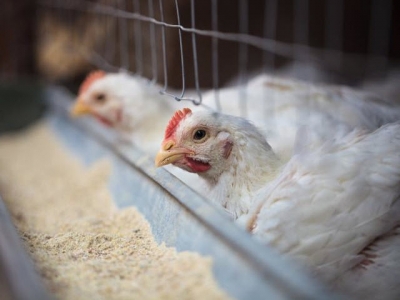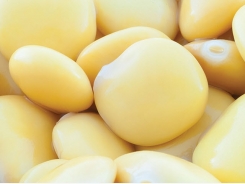Why adding enzymes to poultry diets improves digestion

Improved fiber breakdown leads to increased overall feed digestibility, including amino acids
“Tenemos que poner mayor atención a los factores antinutricionales de las dietas”, apuntó el gerente técnico para Latinoamérica de AB Vista, Alexandre Brito. | hurricanehank, Bigstockphoto
The global digestibility of poultry diets can be improved by addressing the main anti-nutritional factors present in cereals: arabinoxylan chains. The actions of xylanases and the de-branching enzymes arabinofuranosidases are key. Their synergistic action efficiently breaks down the fiber structures, making nutrients more available for endogenous and exogenous enzymes to work on. This feedase effect improves the global digestibility of nutrients, including energy, phosphorus and amino acids.
Getting more from feed: the feedase effect
The ability of efficient enzyme solutions to improve the global feed digestibility is known as the feedase effect.
Adding exogenous complex non-starch polysaccharides (NSP) enzymes, such as xylanase, is known to be of benefit. Poultry are still not able to fully degrade the fiber structures present in plant cell walls. They are made up of arabinoxylan chains, a xylose backbone with arabinose side chains. In order for xylanase to break up these chains, four consecutive unsubstituted xylose molecules need to be accessible. Enzyme activity is therefore hampered by the presence of side chains.




Arabinofuranosidase and xylanase work together to break down arabinoxylan chains. | Adisseo
Arabinofuranosidase de-branches these structures, allowing xylanase to bind to its substrate. By working synergistically, NSP breakdown is improved and the antinutritional effects reduced. This allows the bird’s endogenous enzymes to fully act on the nutritional substrates within the feed.
Improving digestibility
It is accepted that 20 to 30 percent of feed is undigested by poultry. Most of that is associated with plant cell wall components, which are made up of complex NSPs. These anti-nutritional factors reduce feed digestibility in four main ways:
- The cage effect: Endogenous enzymes are physically prevented access to nutrients inside the cell wall.
- Increased gut viscosity: High levels of NSPs in the digesta reduce the effects of endogenous enzymes and reduce nutrient absorption.
- Increasing endogenous losses: By influencing secretory and absorptive processes. NSPs can also cause inflammation in the intestinal tract, affecting absorption and resulting in a metabolic cost for the bird.
- Changing the substrates reaching the hindgut and thus the gut microbiota.
Exploiting the feedase effect will improve the nutritional value of feed by:
- Breaking the xylose chains, improving nutrient accessibility for endogenous enzymes and subsequently their availability to the bird for growth.
- Decreasing the viscosity of digesta, subsequently enhancing nutrient absorption.
- Reducing endogenous losses and mucus production. Also with less inflammation, the demand for amino acids and the subsequent metabolic cost is reduced.
- Positively influencing the substrates reaching the hindgut. Favorable microbiota are enhanced and undesirable bacteria reduced.
Improving amino acid availability
The potential to improve digestibility depends largely on the nutritional value of the diet itself. It has been shown that this can account for up to 90 percent of the variance in response to enzyme addition. For example, the amount that enzymes can improve amino acid digestibility is different for each individual amino acid. This is strongly correlated with the natural inherent unavailability of each amino acid in the diet; which can vary from 10 to 15 percent for methionine and arginine, and up to 30 to 35 percent for cysteine and threonine. It is also related to the negative impact of NSP in preventing their individual digestion – or increasing their endogenous losses.


The inherent digestibilities of amino acids are different; as such the amount by which enzymes can improve it varies. | Adisseo
The aim of a recent broiler study was to evaluate the feedase effect on the ileal digestibility of amino acids in wheat- and corn-based diets. It can be seen, from the control bars, that the inherent digestibility of methionine is higher than that of cysteine. On average, amino acid digestibility was increased by 3.5 percent. The line graphs demonstrate that, as was expected from the literature, there was a greater effect on certain amino acids. In particular, those more involved in gut maintenance such as threonine. The apparent digestibility of threonine was improved by 5.5 percent in the wheat diet and 4.9 percent in the corn diet.
Enyzmes lower costs
Growth and FCR of broilers have improved greatly due to genetics and production techniques. This has meant that nutritionists are required to formulate more nutrient-dense diets, which facilitates this increase in performance within the appetite of the bird. The use of expensive, concentrated protein ingredients and synthetic amino acids has therefore grown, along with the price of feed. By improving digestibility, the nutrient density of diets, and hence cost, can be reduced. The feedase effect will lead nutritionists to address diet composition as a whole and predict a global digestibility improvement when reformulating with an adequate enzyme addition.
Synergistic enzyme activities improve digestibility over and above what is expected for xylanase alone. Ensuring optimum degradation of NSPs potentiates the effects of exogenous and endogenous enzymes. By considering the overall effect of enzymes on the indigestible dietary fraction, the aim of the feedase is to maintain poultry performance, while reducing diet costs.
About Authors:
Pierre-André Geraert is in charge of innovation and scientific Marketing for Adisseo. He joined Adisseo in 1996 after 13 years as INRA scientist on energy metabolism. In 2002, he became R&D Nutrition Director, responsible of technical support, research development and particularly innovation programs for all species and all products. From 2010, Geraert is in charge of enlarging the R&D scope of the company, looking at innovation strategies and develop the scientific marketing of new products.
Sofia ZENAGUI is graduated in Agriculture Engineering from Ecole Nationale Supérieure Agronomique de Toulouse (France). She has worked for almost five years in a French cooperative as a marketing manager. She joined Adisseo in August 2016 to support the marketing development of the enzyme range. She is also in charge of the marketing of Selisseo®, the new organic selenium based antioxidant.
Related news
Tools

Phối trộn thức ăn chăn nuôi

Pha dung dịch thủy canh

Định mức cho tôm ăn

Phối trộn phân bón NPK

Xác định tỷ lệ tôm sống

Chuyển đổi đơn vị phân bón

Xác định công suất sục khí

Chuyển đổi đơn vị tôm

Tính diện tích nhà kính

Tính thể tích ao




 Enriched environments may aid chickens' response to stress
Enriched environments may aid chickens' response to stress  Fatty acid metabolism could lead to new 'designer'…
Fatty acid metabolism could lead to new 'designer'…